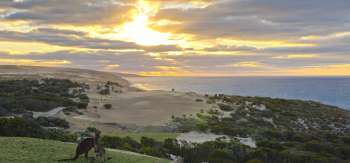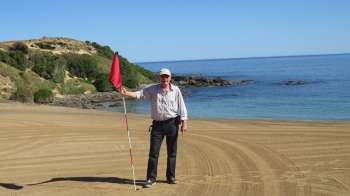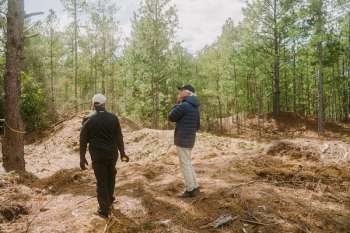Worth the Wait - The Masters comes to Metro
Later this month Adam Scott will attempt to become the first golfer in history to win the Australian Masters Tournament three-times in succession. He will do so at the Metropolitan Golf Club on Melbourne’s famed Sandbelt, a course he once described as up there with Royal Melbourne and Kingston Heath as Australia’s best. As with previous major events staged at Metropolitan, the competitors at this years Masters are certain to be pampered by what many regard as the finest fairways and greens in the world. Despite being an obvious highlight of the golf experience, there is more to Metro than just great grass.
Metropolitan was founded by a group of Royal Melbourne members who initially resisted that club’s 1901 move from Malvern to the southern Sandbelt region. A few years later these stay-at-homers ran out of space and had to move as well, to farmland in nearby Oakleigh and a golf course laid out by an engineer member named J.B. Mackenzie.
Mackenzie’s course was tweaked by his more famous namesake, Dr Alister, during the Englishman’s whirlwind visit to south-east Australia in 1926. It was again altered in the 1960s, this time by Dick Wilson after the club had lost a significant chunk of its back nine to a local school development. Wilson won the design contract in favour of fellow American Robert Trent Jones, who had also submitted a routing for the redevelopment but never set foot on the property. Wilson did visit Metro, but after winning the design he never returned and left construction of his holes for the golf club to oversee.
Wilson’s holes have always been in contrast to the feel and flavour of the original nine, partly because the terrain is flatter and less interesting on the back side but also because the ground underneath the golf is rock hard clay, as opposed to the sandy base of the front nine. There are rumours that the market gardener who sold his land to the club for the new back nine stripped it of all the good material prior to hand-over. Regardless of the reason for the inferior soil, the fact the club has managed to present such immaculate playing conditions over the years is a testament to the skill and dedication of its greenkeeping staff.
The most significant changes made at Metropolitan since the Wilson redesign occurred from 2006 onwards with the appointment of long-time club member Mike Clayton as consulting designer. Clayton and his partners have made major changes to the 12th, 13th and 14th holes, and minor revisions elsewhere. These include a new back tee on the 16th and the rebuilding of the fairway bunkers on the 15th. They also recommended a back tee be added to the 1st hole, although in a different location to the one constructed by the club.
What the Clayton changes have done to Metro is give a more uniform feel to the layout, despite obvious contrasts remaining between the two nines. The removal of numerous trees and the installation of sandy areas have also helped. His work hasn’t been universally appreciated by all at the club, but the Metropolitan we see today is probably the best its been since the 1950s. Those who remember the original back nine describe it in glowing terms and as being clearly superior to the modern version. Legendary American Gene Sarazen won the Australian Open at Metro in 1936 and later nominated the 14th hole as one of the best in the world.
The sad loss of this hole and others has been somewhat offset by continued turf excellence and member facilities that are second to none. A $12 million clubhouse redevelopment was completed last year, capturing glorious views of the golf course from lounge and bar areas and creating precisely the sort of ambience necessary at an elite private club like Metro. It was the first re-build of the original 1908 clubhouse, and is sure to prove a perfect space to relax and unwind for competitors in this year’s Masters.
On course competitors are even better off, with Metropolitan’s famous Wintergreen and Santa Ana couch fairways yet again looking superb. The greens should be on the quick side and the club’s practice of cutting the putting surface right to the edge of the bunkers makes them even more dangerous, as the margin for error is effectively reduced. As with all the good Sandbelt courses, the rewards are there for players able to drive accurately and strike precise irons into the firm greens.
Key front nine holes are sure to include the recently extended opener, a beautifully bunkered dogleg par four where driving on the tighter inside line is preferred, and the short but dangerous 2nd, one of Melbourne’s most attractive par threes. The 5th hole is arguably the club’s best, and certainly the most interesting for the undulation in the fairway, the abundant bunkering and a sharply angled green with an ingenious bump in its front.
The mid-length par five 8th and dogleg par four 9th are also blessed with terrific green complexes. The 8th has long been a Sandbelt favourite, its skinny green protected on the left by deep bunkers and in the front and right side by a clever chipping swale. Appearances from the tee of a flat, innocuous looking birdie hole are often very mistaken here. By contrast, the 9th looks anything but straightforward as it bends aggressively through trees and rises into a terrific target.
On the back nine the standout is probably the strong par four 15th, a classic MacKenzie style hole with an angled green guarded by deep traps and set up to best accommodate an approach shot played from near a bunker on the inside of the fairway. The next is equally famous, but far less strategic as bunkers line the fairway and encircle the green, forcing most to simply layup from the tee and rely on their short-iron approach shot for a chance at birdie.
The bunkering on the Mike Clayton/Mike Cocking designed 12th is much more interesting, as it both splits the fairway and also eats into the front of the green, making your choice of line and length from the tee crucial. Their par three 13th hole has been rebuilt a couple of times, with the current version also dominated by sand and requiring a brave iron shot over a deep bunker in order to hold an acutely angled green.
The finish at Metro is classic Melbourne Sandbelt, with the long par four closing hole known for its slippery tiered green and an immense bunker complex complete with an island of native vegetation. The 18th was lengthened to 434 metres prior to the 1997 Australian Open, won by Lee Westwood in a playoff over Greg Norman. Norman was also denied an Australian Open at Metropolitan by Jack Newton in 1979, who took the title after Norman three-putted the 72nd hole. Other winners of the Aussie Open here include Peter Thomson, Rodger Davis and Brad Faxon, along with Laura Davies who won the 2009 Women’s Australian Open.
The last major men’s tournament played at Metro was in 2001, when the club’s Centenary was recognised by the PGA Tour who awarded them the World Match Play Championship. Despite being universally praised by players and officials in attendance, the event disappointed due to the number of highly ranked stars who were absent from the 64-man field. This year it's not a World Golf Championship event, but the Australian Masters has tradition in this country and, in Metropolitan, it has itself a wonderful host for the 2014 edition.
Darius Oliver, Architecture Editor Australian Golf Digest Magazine
Back to News
More News
The Cliffs Kangaroo Island Announces Preview Play in early 2026
Major milestone for stunning new destination course with preview play available from January 2026
Who Really Designed Cape Wickham Links?
AGD ranks Cape Wickham #1 in Australia & interviews Duncan Andrews to get full story on course design
Cape Wickham Links – The Inside Design Story
Co-designer Darius Oliver reveals the truth behind the design of Australia’s premier modern golf course
Coore & Crenshaw to design new No. 11 Course at Pinehurst Resort
Pinehurst announces that famed design team will design its 11th course on the former Sandmines site




